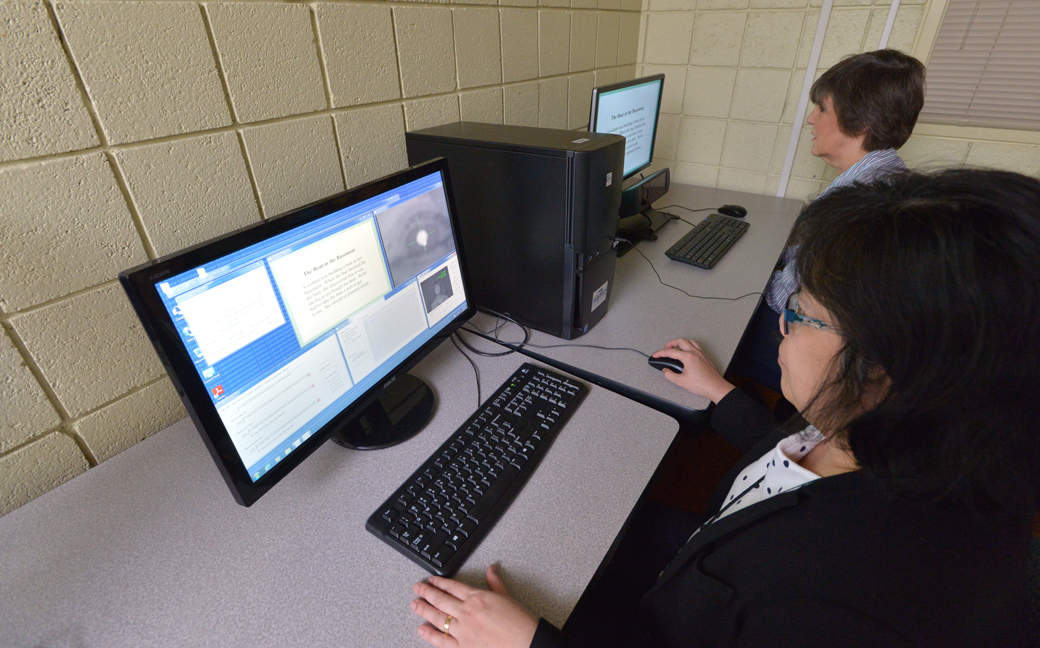TU to host Eye Movement Miscue Analysis Conference
Faculty researchers from COE, CHP and COFAC recently opened an EMMA Research Center on TU's campus.

The old saying goes “The eyes are a window into someone’s soul.” But through great amounts of time and research, the eyes can also teach us how that someone comprehends information they read.
Eye Movement Miscue Analysis (EMMA) brings two research traditions (Eye Movement Research and Miscue Analysis Research) together to study how perception relates to comprehension in reading.
Towson University features four researchers in this field from three different colleges. TU’s EMMA team includes faculty members Maria Perpetua Liwanag and Prisca Martens from the College of Education, Christina Pelatti from the College of Health Professions, and Ray Martens from the College of Fine Arts and Communication.
Through their research, the four TU faculty members were able to open the Towson University EMMA Research Center based in the College of Education. The center is one of only nine EMMA Labs in the world.
Working in their lab, the group uses a desktop eye tracker and a mobile eye machine to examine how various participants read a variety of multimodal texts, and also examine eye movements in reading. The group was able to collect eye tracking and voice pilot data from a diverse group of test readers, ranging from elementary school students to adults.
With their research, the group is looking to drive theory, practice and an overall understanding of the process of reading.
“One of the unique traits about us is that we all come at it from a slightly different perspective,” Pelatti said. “I’m a speech pathologist, (Liwanag and Prisca Martens) are educators and (Ray Martens) is an artist. We’re interdisciplinary, and we are across three colleges and from three different professions. But we have the ultimate goal to have a better understanding of the reading process.”
Recently, the TU EMMA team was awarded a $10,000 grant from the School of Emerging Technology (SET) for their innovative research. SET is located at Towson University, and works to advance interdisciplinary and collaborative educational and research programs that address the development, application, implications and ramifications of emerging technologies.
Each member of TU’s EMMA team is using their research to help in their different fields of study. For Liwanag and Prisca Martens, they are hoping to use their research to help future educators have a better understanding of how students comprehend what they are reading.
“We want to take what researchers have done and move that to the classroom,” Liwanag said. “We want to better understand what a student is doing when they read, and apply that with how we teach. It also helps to teach parents. Showing them what their children actually do and helps to invite them to get involved.”
Pelatti, who also works as a speech therapist, is interested in the underlying language perspectives, with particular interest in students who have difficulty learning how to read.
“What is the reading process like for students with down syndrome,” Pelatti said. “Is it different? Is it similar? What are we going to learn about their process? Children with learning impairment and how they read, that is how I’m approaching it.”
When performing their research, the subjects have been using reading material that features pictures. According to the group, this is different from the usual research that features just a book of text.
Ray Martens, a professor in Art Education and a professional artist, hopes to use this research in helping his fellow artists understand that reading is more than just looking at words.
“You have to be able the read the visual text to fully understand,” he adds. “I ask my art education students to give me a definition of reading, and they give me just a literary definition. It’s so much broader than that.”
This group of researchers will host an EMMA Conference at Towson University for some of the top international researchers in the country from June 10-12. The conference will be sponsored by the College of Education.
“I am pleased to host the EMMA researchers in the College of Education as it continues our legacy of the study of reading for all learners," said Laurie Mullen, dean of the College of Education.
The purpose of the conference will allow EMMA researchers to:
- Share current work on EMMA research applications in literacy
- Discuss theoretical method for eye track and issues related to eye-brain connections
- Discuss methodology through the lens of reading as a dynamic process when creating an EMMA taxonomy, documenting eye-tracking measures (data collection, data quality, problems and solutions) and understanding algorithm of event detections (gaze points and fixations)
- Collaborate to write and publish articles and an EMMA book
- Collaborate across national and international universities to lead the group in writing and submitting research for external grant funding.
Invited EMMA researchers will be joining the conference physically and virtually. Among those who will participate will be researchers from the University of Arizona, Hofstra University, Wayne State University, University of Louisiana at Lafayette, Southern Illinois University, New Mexico University and the Bahrain Bayan School.
There will also be a consultant from Argus Science, an independent consulting agency with knowledge of the desktop and mobile eye trackers at the Towson University EMMA Center Lab, who will discuss the eye track hardware properties and software with the conference attendees.